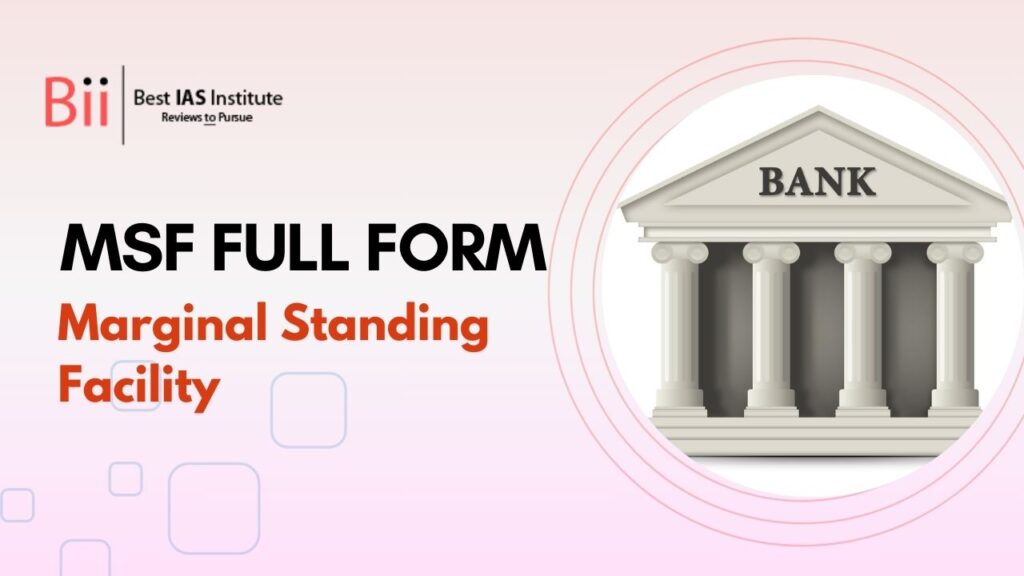
What is MSF full form?
The Full Form of MSF is Marginal Standing Facility. Banks concerned borrow from the central bank using Marginal Standing Facility (MSF), which is done by guaranteeing government securities at a rate higher than the repo rate This will facilitate the banks to raise money quickly within a day.
| MSF Full Form | |
| MSF Full Form | Marginal Standing Facility |
| Full Form in Hindi | “सीमांत स्थायी सुविधा” |
| Establishment | 2011 |
| Governing Body | Reserve Bank of India (RBI) |
| Current Marginal Standing Facility rate | 6.15% |
| Beneficiaries | Commercial Banks Operating Under RBI |
Origin of Marginal Standing Facility (MSF)
In the year 2011–12, the Reserve Bank of India implemented the Marginal Standing Facility (MSF), which came into force on 9 May 2011. 1 billion was paid in the first year under this facility. The objective of the implementation of this new monetary adjustment policy was to stabilize the overnight lending rates at the banks, facilitate financial efficiency in the banking system. This provided The Reserve Bank of India was able to effectively control the amount of money in the country’s monetary policy.
Meaning of Marginal Standing Facility (MSF)
The amount that banks can borrow from the RBI overnight is called the marginal standing facility. Overnight liquidity is allowed for certain commercial banks, one of the key guidelines set by the Reserve Bank of India. This helps when all the water has evaporated. Banks use MSF as an emergency way to raise liquidity at MSF rates. To support banks in difficult situation and help RBI maintain liquidity through the economy, Reserve Bank of India introduced Marginal Standing Facility (MSF) in FY 2011–2012
A bank can only have a maximum loan of 3% of its total deposits under MSF (NDTL). Because of its urgency, banks can use the protection covered by the SLR quota without penalty. By doing this, banks will be protected from overnight interbank interest rate fluctuations.
Marginal Standing Facility (MSF) Rate
The Marginal Sustainable Facility (MSF) rate is the interest rate fixed by a central bank, such as the Reserve Bank of India (RBI) as part of its monetary policy. This is the interest rate at which scheduled commercial banks can borrow from the central bank overnight against approved collateral, usually government banks.
The MSF rate serves several purposes:
- Use of funds: The high value of MSF acts as a reason why banks are less likely to use this system, which encourages responsible use of funds Banks are encouraged to raise funds from the market or other areas before contacting MSF.
- Instant funds: The MSF rate is higher than the repo rate to reflect the cost of immediate funds. Banks can raise funds quickly in times of unexpected economic distress, thereby enhancing the stability of the banking system.
- Monetary policy indicator: The Marginal Standing Facility (MSF)rate is above the repo rate, indicating a more restrictive monetary policy position. Central banks can manipulate the MSF price to influence short-term interest rates and to control economic conditions in the market.
- Market stability: The difference between the MSF rate and other rates provides a buffer against overborrowing from the central bank. This contributes to the stability of currency markets.
Importance of Marginal Standing Facility (MSF)
The Marginal Standing Facility (MSF) is very important in terms of monetary policy and financial stability. MSF is considered important here for several main reasons.
- Liquidity: Marginal Standing Facility (MSF) provides central banks with an important tool to monitor liquidity in the banking system. It is a place where banks can obtain funds as short-term unexpected charges, ensuring the smooth functioning of the payment and settlement process
- Emergency funding: Banks may face difficulties in raising funds from conventional sources during periods of financial stress or sudden liquidity shortages in the financial markets. The MSF acts as a backup, providing banks with a way to quickly access funds and meet their emergency liquidity needs.
- Market Positioning: By raising the MSF rate above the repo rate, central banks encourage banks to exhaust alternative sources of funding before relying on MSF This forces liquidity in a responsible manner and reduces the risk of market deterioration due to over-borrowing from the central bank.
- Interest rate control: Short-term interest rates are affected because the MSF rate is higher than the repo rate. Central banks use the MSF rate as a tool to determine their position on monetary policy and influence market interest rates.
- Monitoring speculative activities: The difference between the MSF rate and the repo rate prevents banks from engaging in speculative activities, as the high cost of borrowing through the MSF slows down how the use of positions for short-term profits decreases
Key Related to MSF
The following key terms associated with the Marginal Standing Facility (MSF):
- NDTL (Net Demand and Time Deposit Liabilities): NDTL refers to the total demand and time deposits of a bank minus interbank deposits. It is an important factor in determining a bank’s reserve requirements and affects its creditworthiness.
- SLR (Statutory Liquidity Ratio): SLR is the percentage of a bank’s needs and duration to hold in liquid assets, such as cash, gold, or government securities. It helps banks’ loans and liquidity viable and supportive of budget objectives.
- Repo Rate: The repo rate is the interest rate at which the central bank lends money to commercial banks against government securities. It is an important tool for monitoring liquidity in the banking system and influencing short-term interest rates.
- Reverse Repo Rate: The reverse repo rate is the interest rate at which commercial banks can lend to the central bank by depositing excess liquidity. It helps the central bank control the money supply and regulates the flow of money into the market.
- Treasury Rate: Treasury rate is the interest rate at which the central bank lends banks to commercial banks for a long period of time, and it often affects the cost of borrowing in the economy and plays a role in keeping money strong and supporting monetary policy objectives.
Full Form of MSF in Other Fields
| Field | Full Form of MSF |
| Medical | Master of Science in Nursing Facility |
| Technology | Microsoft Solutions Framework |
| Military | Military Surface Fleet |
| Science | Main Science Facility |
| Education | Minority Science and Engineering Program Facility |
| Aviation | Mission Support Flight |
| Sports | Maximum Sustainable Yield Formula |
Conclusion
In conclusion, Marginal Standing Facility (MSF) plays an important role in the banking system. It gives life to banks that need money quickly, and offers higher interest rates in the face of unexpected cash shortages This facility acts as a safety net, ensuring that banks can meet their obligations and maintain financial stability. Understanding MSF is important for anyone interested in banking and finance, as it reveals the mechanisms available to protect against potential problems. Overall, MSF remains a resource of importance in monetary policy and the banking management system.
FAQs
Q1- What is the purpose of the Marginal Standing Facility?
A- The MSF is designed to regulate liquidity in the banking system and provide emergency funding to banks during short-term financial distress.
Q2- How does the MSF rate compare to the repo rate?
A- The MSF rate is typically set higher than the repo rate to reflect the additional cost of securing overnight funds and to discourage excessive reliance on central bank funds.
Q3- What are the eligibility criteria for accessing MSF?
A- Banks can access MSF up to 3% of their Net Demand and Time Liabilities (NDTL), using government securities as collateral.
Q4- How has MSF evolved since its inception?
A- Since its establishment in 2011, MSF has played a crucial role in stabilising the financial system by managing liquidity and interest rates effectively.
Q5- What impact does MSF have on the Indian banking sector?
A- MSF ensures that banks have a safety net for immediate liquidity needs, thereby maintaining stability and supporting smooth financial operations.
Real More full Form related articles



